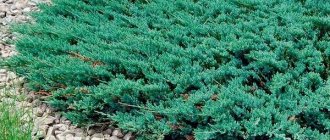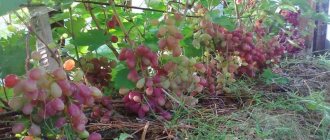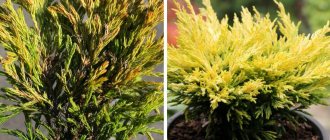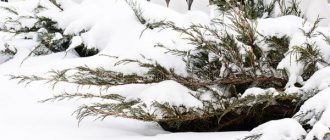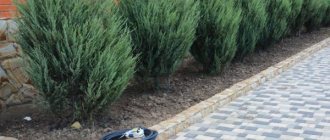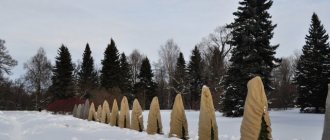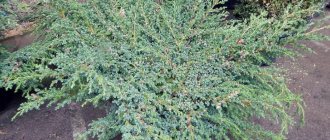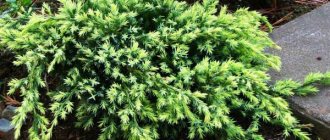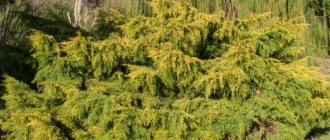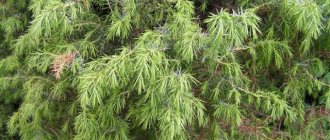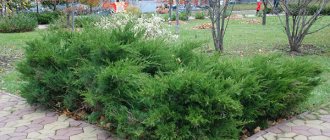Description of Juniper Horstmann
Juniper Horstmann Pendula was obtained in 1975 in Europe. It is an evergreen perennial with a cone-shaped crown and creeping lower branches.
Despite the fact that the upper shoots of the Horstmann juniper grow vertically, their tops are drooping
The older the plant becomes, the lower the tips of the branches drop, and a clearly visible trunk is formed, so crops are often grown like a short tree, although pruning allows you to obtain almost any shape.
Horstmann juniper needles have a standard structure for the family; it consists of three scale-like leaves in one whorl
The length of the leaves does not exceed 10 mm. The cone berries have a bluish tint and ripen in the second year after fertilization. Horstmann juniper wood is hard and durable, with a slightly reddish tint.
Frost resistance of juniper Horstmann
The plant belongs to the fifth frost resistance zone. That is, common juniper Horstmann is able to withstand temperatures down to -29 °C. Considering that the plant is not particularly demanding on the composition of the soil (even though it is a calciphile), the main factor limiting its spread is temperature.
In Europe, the plant is found everywhere except in the north of Scandinavia. In Asia, its distribution is limited to Western Siberia. Horstmann juniper is not found in the Southern Hemisphere. In North America, it does not grow in northern Canada.
Size and growth rate
Horstmann juniper reaches a height of 2.5 m. The crown diameter can be up to 2 m. The growth rate is 15-20 cm per year.
To increase height, it is recommended to plant Horstmann juniper in sunny areas in alkaline soil. Feeding it with nitrogenous fertilizers in early spring also helps.
Description of the variety
The botanical name of Horstmann juniper is juniperus communis Horstmann. It belongs to the evergreen coniferous plants. Lifespan is up to 200 years. An upright shrub reaches 2m in width and 2.5-3m in height. It grows quite quickly: the annual growth is 10-15 cm. The branches at the base are directed upwards and to the sides, their ends bend towards the ground, giving the crown a weeping shape. The color of the needles is dark green, sometimes with a bluish tint. Rigid triangular needles, about 15 mm in length, very prickly. Changed every 4 years.
The branches at the base are directed upwards and to the sides, their ends bend towards the ground, giving the crown a weeping shape.
Juniper blooms in May-June. Yellow male flowers, collected in spikelet inflorescences, appear in the axils of last year's shoots. Female, green, grow on short side shoots. The cones, green with a bluish coating, have a round shape and ripen in August-September.
Juniper Horstmann in the landscape
Mostly the plant is grown in the form of single plantings in the center of an open area or flower bed consisting of low-growing representatives of the flora.
It will look harmonious on the shore of a small artificial pond or in a rock garden. In rock gardens it is placed surrounded by large boulders.
Group plantings along paths or circular plantings around gazebos or benches are also used.
Group solutions create the illusion of wild coniferous forests.
Reviews
Antonina Ivanovna, Tula
I have been looking for this plant for so long; I wanted to plant weeping varieties around a decorative pond. After 2 years, the juniper showed all its beauty. It turned out very stylish!
Sergey Luzhnikov, Moscow
When my wife asked for a living garden sculpture, I decided to buy a weeping juniper Horstmann. I placed a frame in the shape of a bird in the corner of a rocky rock garden and planted a juniper tree next to it. Over the course of 4 years, the frame was completely covered with branches, resulting in a living bird. I cut my hair once every 2 years, cutting off only the excess. Juniper does not suffer from anything, does not require special care, and the view is stunning!
Reproduction methods
Horstmann juniper is propagated in several ways:
- layering;
- lignified cuttings;
- grafting onto the rootstock of another conifer;
- seeds.
It is recommended to use any vegetative propagation method, since their effectiveness is approximately the same. The use of seeds is undesirable, since it takes several years, and there is no guarantee that the resulting plants will have the properties of the mother plant.
Important! Growing with green cuttings is not typical for this variety.
Care requirements
Common juniper Horstmann is unpretentious, it brings only joy to its owners.
All care measures are standard: loosening, moistening, sanitary pruning and watering.
Immediately after planting, the seedlings must be shaded from the scorching rays of the sun, otherwise they will quickly burn and die. At lunchtime they are covered with burlap or agrofibre for 2-3 weeks.
Watering
It should be moderate, but frequent: in the first month - every other day. Water consumption per specimen is 10 liters. Regular moistening promotes the rapid growth of new roots and green mass
Later, water as the soil dries to a depth of 6-7 cm and taking into account the amount of precipitation.
Starting from three years old, conifers can be moistened up to four times per season if there is no rain in the summer. Water consumption for an adult juniper is 7-8 buckets.
Additionally, irrigation is carried out in the evening hours, when the sun sets. In hot weather they irrigate every day, in cloudy weather - once a week. This helps maintain the decorative appearance of the crown and free it from dust and harmful insects.
Loosening and mulching
Loosening provides good access of water and oxygen to the roots. It is carried out the next day after moisturizing.
You need to loosen superficially so as not to damage the delicate roots of the ephedra.
Mulching with peat, garden soil or crushed pine bark prevents rapid evaporation of moisture and prevents the growth of weeds.
Along with these manipulations, unnecessary vegetation in the garden is periodically removed, carrion is collected, and the rows are weeded.
Feeding
Fertilizing improves the appearance of the plant
Balanced and annual nutrition of conifers with organic matter and minerals will help to quickly increase green mass, increase immunity against diseases and maintain decorativeness all year round.
The first fertilizer is applied in the fourth year of cultivation, when the plant has used up all the reserves of nutrients provided during planting.
| Season | Drugs | Dosage |
| In early spring, before the buds begin to swell | The soil under each bush is sprinkled with ammonium nitrate or urea | 500 g |
| In summer (in the first or second ten days of July) | Use a complex composition of potassium sulfate and superphosphate | 300 g per plant |
| Autumn - 3-4 weeks before frost | A mixture of superphosphate and potassium sulfate | 350 g per 1 m² |
After each procedure, abundant watering is carried out to speed up and improve the absorption of nutrients, and to prevent burning of the root system.
Additionally, three foliar feedings can be carried out - at the end of March, at the beginning of June and in the last ten days of August. Irrigate the crown in the evening with preparations in chelated form - Epin, Heteroauxin or Epin-extra.
Trimming
This weeping shrub does not need to be shaped; its long, drooping branches form a beautiful, lowered shape. If you want to trim some shoots, it is better to do this in spring or autumn.
At the beginning of spring, when the street temperature stabilizes at around 0-5°C, a sanitary haircut is carried out. All branches damaged by frost, winds, diseases and pests are cut back to healthy tissue.
To avoid infection, take a pre-disinfected and sharp instrument. After pruning, the crown should be irrigated with a solution of copper sulfate, and after half an hour with Epin. This remedy helps the conifer to return to normal faster.
Preparing for winter
Since young plantings are still very weak and freeze at the slightest frost, they need to be insulated a month before the onset of persistent cold weather:
- Sprinkle the tree trunk area and trunk with a high mound of peat or garden soil;
- adjacent branches are bent to the central conductor and tied with twine;
- cover the crown with burlap or spruce branches.
Under such insulation, the seedlings will not freeze or freeze.
Starting from the age of three, shelter will no longer be needed; the conifers are simply covered with garden soil, and, if necessary, in snowy winters the branches are shaken off from snow to prevent them from breaking off.
Planting and caring for Horstmann juniper
Planting can be done in soils of any fertility, but they must have slightly alkaline acidity. It is recommended to lime soils that are too acidic with wood ash. The plant does not tolerate shade, since its development practically does not occur in it. The distance between landing points is at least 1.5 m.
Before planting, preliminary preparations should be made. The pit is prepared about a week before planting. Its diameter should be 25 cm larger than the size of the juniper root system, and its depth should be 30 cm greater.
A drainage 15 cm high and a layer of fertile soil of the same height are laid at the bottom of the hole.
Important! The root collar of the Horstmann juniper should be 5-6 cm above the ground level.
On the day of planting, it is recommended to immerse the roots of the plant in a 0.5% solution of potassium permanganate for disinfection for 2 hours. After which the bush is placed in a hole on a layer of soil, the roots are distributed evenly and sprinkled with a layer of soil.
Juniper is planted together with a lump of earth
This is followed by compacting, watering and mulching. Watering amount is 1-2 buckets depending on the size of the root system.
Reproduction
There are two ways to propagate this crop - by seeds and cuttings.
The first option is labor-intensive, requires a lot of patience and does not always give the expected result. In addition, it is rarely possible to obtain a varietal specimen from seeds.
Therefore, most gardeners prefer the second method.
Harvesting and planting cuttings
Germination of shoots is carried out at home. They are cut in the summer (late June or early July).
Use apical parts 15-20 cm long with a piece of lignified bark. To prevent the cuttings from drying out, they are planted immediately after cutting in a moist and nutritious mixture of sand and peat (1:1). Planting is carried out at an angle of 45° to a depth of 3-4 cm.
For convenience, you can take plastic containers or seedling boxes. To eliminate the risk of shoots rotting, several holes are made at the bottom of the container to drain excess moisture, then 5-7 cm of pebbles or expanded clay are poured on top of loose, fertile soil.
Basic care
The bush grows quickly
For successful rooting, the cuttings are watered with warm water and covered with film. The mini-greenhouse is placed in a warm place with diffused daylight.
The optimal temperature is 18-19°C, humidity is 60-65%.
Germination can take 2 to 3 months. During this time, planting should be periodically irrigated with warm water, the soil should be loosened superficially to avoid the appearance of an earthen crust, and also ventilated daily.
As soon as the first buds appear on the shoots, you can remove the shelter and transfer the plants to a warm room with a temperature of 20-23°C.
Young conifers continue to grow at home until next autumn, then they are transplanted to a permanent habitat in the garden.
Aftercare
Caring for Horstmann juniper consists of periodic watering and pruning of the plant. An adult crop does not need fertilizing; only bushes that have not reached three years of age need it.
Watering and fertilizing schedule
Horstmann juniper is quite hardy and makes do with natural precipitation when it comes to watering. Only in dry summers should it be watered, but no more than 3 times per season. The norms are from 30 to 40 liters.
Important! Young plants need watering in the first 2 months after planting. Their frequency is 1 week.
Feeding is needed only for young plants in the first 2-3 years of life. They are applied in the spring in the form of complex fertilizers for coniferous crops.
How to shape Horstmann juniper
Horstmann juniper is formed on average once every two years, depending on design decisions. Usually this procedure is carried out simultaneously with sanitary pruning in early spring. In this case, the plant can be given almost any shape, the main thing is not to get too carried away with trimming the lower part of the crown, the plant should be more or less symmetrical.
Mulching, loosening the soil
There is no need to mulch mature plants or loosen the soil underneath them. For young specimens, this procedure is relevant and should be performed at the end of each watering. At the end of the 2-3 month period after planting, the plants are mulched with peat or sawdust.
How to cover Horstmann juniper for the winter
The culture does not need shelter for the winter. Only a small hilling of young plants before wintering is allowed in the first year after planting.
Landing rules
One of the main rules for the successful survival of seedlings is planting within a strictly established time frame.
This plant of the Cypress family should be planted in the spring (the last ten days of April or the first days of May) so that the seedlings have time to take root and prepare for wintering. In the southern zone, autumn planting is allowed - in early September.
Selection of seedlings
You can buy Horstmann junipers in one of the specialized nurseries. The price for one copy with a height of 80 to 100 cm is 1800 rubles.
There are several places in Moscow where you can buy this conifer - Ecoplant, Agrosad, a nursery of rare conifers.
It is worth carefully examining the plant - it must be strong and healthy. You can determine viability using the following criteria:
- shoots are flexible, light brown in color, do not contain cracks, growths or rotting;
- needles of a uniform dark green tone without black, yellow and red inclusions;
- roots without acidification and rot.
It is better to opt for seedlings 2-3 years old with a ball of earth or planted in containers. Plants with a closed root system do not dry out as much and take root safely after transplantation.
A couple of hours before planting, the underground part is saturated with moisture, conifers with exposed roots are lowered into a container of water for 40 minutes.
Preparing the site
For weeping juniper, a sunny or slightly shaded area is suitable. The needles of this variety can safely withstand the sun, so they do not burn and remain decorative all year round.
Choose a place for planting with deep groundwater - up to 2.5 m. If this is not possible, you need to add a thick layer of drainage - sand with screenings - 2 buckets per 1 m².
Juniper tolerates sunlight well
This crop grows well on loamy, sandy soil with a neutral acidity level and a high degree of fertility. When planting on sandy loam, add 20 kg of clay. If you decide to grow on loam, you need to sprinkle the bed with sand and peat - 20 kg per 1 m².
To reduce acidity to 6 units. you will need 350-400 g of powdered chalk or slaked lime per 1 m². After this, the soil is dug up, leveled and watered.
Landing technique
Two weeks before the planned transplant, holes are dug, two times larger than the root system.
- Half a bucket of drainage made from pebbles, screenings, crushed stone and brick chips is poured into the bottom.
- A fertile composition of peat, turf, sand and pine sawdust is poured from top to half at a ratio of 2:2:1:1. Additionally, add one handful of potassium sulfate and superphosphate.
- Spill with water (2 buckets). After it is absorbed, the roots are lowered, covered with ordinary garden soil, and trampled down in the area of the tree trunk. Moisten again at the rate of 20 liters per seedling.
- Mulch with peat or pine chips to avoid rapid evaporation of moisture.
When growing in groups, it is important to keep a distance, otherwise there will be competition for moisture and space, and the weakest conifers will die. The optimal planting pattern is 3x2 m.
When planting, you cannot deepen the root collar, otherwise it will rot and the seedling will quickly wither.
Pests and diseases
Common juniper Horstmann is characterized by all diseases of this genus. Typically, representatives of the family are attacked by the following diseases: rust, drying out of branches, Alternaria, brown scute, fusarium.
Each variety has its own, most dangerous diseases. Horstmann juniper is most damaged by drying out of the branches. Its causative agents can be several fungi at once, mainly from the families
Symptoms of the disease - the needles turn yellow and fall off, the branches dry out
Control measures are standard for fungal diseases: adherence to agricultural practices, removal of affected branches, treatment of remaining undamaged areas with copper-containing preparations (solution of 1% copper sulfate).
Another equally dangerous disease of Horstmann juniper is Alternaria. It is also a fungal infection caused by spore fungi. The branches of the plant located below are usually affected.
The main symptom of Alternaria is the appearance of a whitish coating on the branches on one side of the bush, spreading from bottom to top.
Infection control measures are similar to those for treating branch drying.
Rust manifests itself in the form of swelling of juniper branches and the formation of orange growths on them
This color is due to the presence in the mycelium of the fungus of oil droplets containing a pigment similar to carotene. A plant can suffer from this disease for many years, and if no action is taken, it loses its decorative appearance and eventually dies. Treatment consists of removing the affected branches and treating the remaining part of the bush with fungicides.
Attention! After cutting branches with mycelium, the pruning shears should be treated with alcohol.
Brown Schutte most often appears at the end of the season, when the spores of the fungus that causes this disease mature. Before this, the parasite does not manifest itself in any way.
At first, yellow spots appear on the needles, which over time acquire a brown tint.
The disease spreads from the lower branches, gradually rising higher. Adult plants can lose up to 30% of their needles, while young plants, up to 3 years old, lose them completely and die.
When the color of the needles begins to change, nothing can be done. It is recommended to remove damaged branches and treat the remaining parts of the plant with Fundazol or Zineb. The following year, the same drugs are used for preventive treatment of the crop.
Fusarium is a disease that affects many plants, including Horstmann juniper. Fungi of the genus Fusaruim cause rotting of the root system, which leads to a change in their color and inability to obtain nutrients from the soil.
Over time, the entire plant affected by fusarium becomes brown and dries out.
The fight against the disease consists of timely rejection and destruction of all dried specimens along with the root system. For prevention, it is recommended not to plant the crop in wet places. Also, before planting, you should treat the roots of the plant in a solution of Baktofit or Vitaros.
Horstmann juniper can be parasitized by many pests that feed on coniferous crops, but have a narrower specialization. These include the juniper gall midge, the flat beetle mite and the juniper moth.
Gall midges pose a particular danger to Horstmann. These are small flies that lay eggs in the growth cone of juniper trees.
The secretions of the larvae stimulate the formation of a gall - several closed whorls of needles at the top of the shoot
While inside its shelter, the larva not only feeds on the sap of the plant, but also suppresses the development of the shoot. All this leads to stunted plant growth. The fight involves treating the affected bushes with systemic drugs 2-3 times with a break of 2 weeks.
The flat beetle mite is a small red arthropod that parasitizes juniper trunks
They usually hide in folds of bark or under dead scales of pine needles. The symptoms of the lesion resemble fungal diseases that lead to plant wilting, but, unlike them, it does not have a clearly defined source. The juniper begins to dry out simultaneously on all its parts.
This pest is immune to organophosphorus agents, so selective acaricides are used to combat it: Fitoverm, Aktofit, Marshall.
Also an unpleasant pest is the juniper moth, the larvae of which feed on young shoots of the Horstmann juniper. Their attacks can be massive; they are capable of destroying all the needles on a plant in a matter of days.
The larva of the juniper moth prefers to be in the lower part of the branches.
To combat this pest, you need to use systemic drugs such as Enzhio, Clipso and Confidor. Treatment should be done 2-4 times with an interval of no more than 12 days.
Diseases and pests
The juniper variety has stable immunity to infection; if there are no fruit trees nearby, the plant does not get sick. There are few pests that parasitize shrubs, these include:
- juniper sawfly. Get rid of insects using Karbofos;
- aphid. They destroy it with a soap solution, cut off areas where parasites accumulate, and get rid of nearby anthills;
- scale insect. Eliminate insects with insecticides.
In the spring, for preventive purposes, bushes are treated with products containing copper.
Brief information about common juniper Horstmann
Height: 2.5 – 3 m. Crown width: 2.0 m. Form: vertical shrub with drooping shoots.
Needle color: dark green. In what regions does it grow: in all except the Far North and desert. Relation to lighting: sunny places with slight shading, at a distance of 1.5 m from each other.
Immunity: to rust, subject to proper cultivation practices. Life expectancy: about 200 years.
If you are a lover of elegant exotics, then the Horstmann variety of common juniper is for you. And in vain they call him ordinary. This is a real miracle!
Use in landscape design
This variety of juniper is often used to decorate garden landscapes. Staircases are often decorated with such coniferous plantings. In this case, they are planted in large numbers on the sides of the structure. To make the design more interesting, coniferous plants can be diluted with several deciduous shrubs or bright flower beds.
You can make a separate flower bed near the house or near the stairs. It is worth decorating it with the help of decorative stones. In the middle, a taller and slender coniferous tree with rich and bright colors should be planted. It needs to be surrounded by plantings of miniature junipers. You can also place several deciduous plantings with different foliage colors here.
These coniferous shrubs can be used to decorate stone paths in the garden. Or decorate a hedge. You can plant juniper bushes on both sides of the paths at once. It is permissible to combine such plantings with taller coniferous representatives.
Review of the Horstmann juniper in the video below.
Description of the plant
The scientific name of Horstmann juniper is juniperus communis Horstmann. This is an evergreen coniferous shrub, reaching a height of 2 m and a crown width of 1.5 m by maturity (10 years). After this age, annual growth slows down. The juniper reaches its maximum height - 3 m - by 200 years of age.
Juniper differs from other varieties in its unusual drooping crown, which is created by vertical skeletal branches, the ends of which are directed to the side and down.
The needles are short, prickly, dark green, and do not change color throughout the year. The life span of the needles is 3 years, after which they are gradually replaced by new ones.
The branches are reddish-brown in color, effectively set off by lush green needles.
The root system is superficial, fibrous.
Juniper blooms annually in May, forming male (in the form of yellow spikelets) and green female flowers. The bluish-colored cone berries ripen in August and early September.
Horstmann juniper does not lose its high decorative value at any time of the year: it does not fade in the sun and does not acquire a bronze tint with the onset of autumn.
